
What to do?
1. Soak in the beauty of the Taj Mahal
Visiting the Taj Mahal is an awe-inspiring experience that transports you to a realm of timeless beauty and architectural grandeur. As you approach the monument, the ivory-white marble structure emerges on the horizon, framed by lush gardens and reflecting pools. The intricate carvings and delicate inlay work on the walls create a mesmerizing interplay of light and shadow. As you step through the grand entrance gate, known as the Darwaza-i Rauza, the Taj Mahal unfolds itself in all its splendor. The main mausoleum, crowned by its iconic dome, stands as a symbol of eternal love and a masterpiece of Mughal architecture. Inside, the cenotaphs of Shah Jahan and Mumtaz Mahal, the emperor and his beloved wife, are surrounded by intricate marble screens, each telling a tale of enduring love and craftsmanship.
The story behind the Taj Mahal adds a poignant layer to its majestic presence. Commissioned by Shah Jahan in memory of his beloved wife Mumtaz Mahal, who died during childbirth in 1631, the Taj Mahal is a testament to undying love. The emperor spared no expense to create this exquisite mausoleum, employing thousands of artisans and craftsmen to bring his vision to life. The construction took over two decades to complete, and the Taj Mahal became a symbol of eternal love and grief. Shah Jahan himself was eventually buried alongside Mumtaz Mahal in the same tomb, their love story immortalized in the pristine marble walls of this architectural marvel. Today, visiting the Taj Mahal is not just a journey through time and architecture but also a pilgrimage to the enduring legacy of a royal love story.
Visiting the Taj Mahal is a remarkable experience, and careful planning can enhance your trip. Here are some tips to make the most of your visit:
Timing is Key:
Sunrise or Sunset: The Taj Mahal looks particularly stunning during sunrise and sunset. Consider planning your visit during these times for the best lighting and a magical atmosphere.
Weekdays: Weekdays are generally less crowded than weekends, allowing for a more peaceful and enjoyable visit.
Purchase Tickets in Advance:
Buy your tickets online in advance to avoid long queues at the entrance. This can save you time and ensure a smoother entry process.
Dress Modestly:
Dress modestly and respectfully when visiting the Taj Mahal. Both men and women should cover their shoulders and knees. This not only shows respect for the culture but also allows you to enter religious areas without any issues.
Security Check:
There is a mandatory security check at the entrance. Be prepared to pass through metal detectors and have your belongings scanned. It's advisable to carry only essential items to expedite the process.
Photography Rules:
Photography is allowed outside the main mausoleum, but it's restricted inside. Be aware of the rules and respect them to avoid any inconvenience.
Guided Tour:
Consider hiring a local guide or using an audio guide to get a deeper understanding of the history, architecture, and stories associated with the Taj Mahal.
Hydration and Sun Protection:
Agra can get quite hot, especially during certain times of the year. Carry a water bottle, wear sunscreen, and consider a hat to protect yourself from the sun.
Respect the Monument:
Avoid touching the marble surfaces and refrain from sitting on the raised platforms. Preservation efforts are ongoing, and respecting the monument helps ensure its longevity.
Explore the Surroundings:
Take some time to explore the gardens and the nearby Yamuna River. The Taj Mahal complex offers picturesque views and serene surroundings.
2. Sunset at Mehtab Bagh
Experiencing the sunset at Mehtab Bagh, a historic garden complex located across the Yamuna River from the Taj Mahal, is a serene and picturesque affair. Mehtab Bagh, also known as the "Moonlight Garden," offers a unique vantage point to witness the changing hues of the Taj Mahal as the sun dips below the horizon.
The tranquil setting of Mehtab Bagh allows visitors to appreciate the Taj Mahal in a quieter and more contemplative atmosphere compared to the bustling crowds at the main complex. The gardens themselves are meticulously laid out, showcasing a symmetrical design that complements the architectural precision of the Taj Mahal across the river.
Whether you choose to capture the moment with a camera or simply immerse yourself in the beauty of the surroundings, sunset at Mehtab Bagh offers a serene and magical experience, making it a memorable addition to your visit to Agra. This riverside retreat provides a different perspective on the Taj Mahal, allowing you to witness its grandeur against the backdrop of a stunning sunset, creating an unforgettable memory of this iconic landmark.
3. Visit the Red Fort
Visiting the Red Fort in Agra is a journey into the rich history of India, offering a glimpse into the grandeur of the Mughal era. Also known as "Lal Qila," the Agra Fort is a UNESCO World Heritage Site and a monument of architectural and historical significance.
Upon entering the fort through its imposing gate, Amar Singh Gate, visitors are transported back to the 16th century, when the fort was constructed by Emperor Akbar in 1565. The red sandstone walls that give the fort its name house a complex of palaces, mosques, and courtyards, each narrating a tale of Mughal opulence and power.
One of the highlights of the Agra Fort is the Jahangir Mahal, a palace built for Akbar's son, Jahangir. Its intricate architecture, with a blend of Persian and Indian styles, reflects the cultural fusion characteristic of the Mughal dynasty. The Diwan-i-Khas, or Hall of Private Audiences, is another remarkable structure adorned with exquisite marble work and a throne platform where emperors held private meetings.
The Musamman Burj, a beautiful octagonal tower, offers a stunning view of the Taj Mahal and is believed to be the place where Shah Jahan, the builder of the Taj Mahal, spent his last days in captivity. The Khas Mahal, Sheesh Mahal, and Moti Masjid are additional attractions within the fort that showcase Mughal architecture at its zenith.
Exploring the Agra Fort allows visitors to appreciate not only the architectural brilliance but also the historical significance of the monument. The fort has witnessed significant events in Indian history, including the imprisonment of Shah Jahan by his son Aurangzeb. The blend of military, residential, and cultural structures within the fort provides a comprehensive view of the Mughal way of life.
Overall, a visit to the Agra Fort is a captivating journey through time, offering a deeper understanding of the Mughal Empire and its architectural legacy. The fort's proximity to the Taj Mahal makes it a must-visit destination for those exploring the historical and cultural treasures of Agra.
3. Go see the artisans work
Exploring the artisan workshops in Agra can be a fascinating and enriching experience, providing insight into the intricate craftsmanship that has been a hallmark of the city for centuries. Agra is renowned for its skilled artisans who specialize in various traditional arts and crafts, with marble inlay work being one of the most celebrated.
One of the primary places to witness this craft is at the marble workshops near the Taj Mahal. Skilled artisans delicately carve and engrave marble, creating exquisite pieces of art and decor. The process involves the meticulous placement of semi-precious stones into the marble to form intricate patterns and designs. Visitors have the opportunity to observe the artisans at work, gaining a deeper understanding of the craftsmanship that goes into creating the beautiful marble products.
In addition to marble inlay work, Agra is known for its carpet weaving, embroidery, and leatherwork. The Sadar Bazaar area is a bustling market where you can find these traditional crafts being practiced and showcased. Carpets of various designs and sizes are often woven by hand, showcasing the artistry and precision of the local weavers. A visit to the bazaars allows you to witness the vibrant colors of Agra's traditional textiles and fabrics, often adorned with intricate embroidery.
To make the most of your visit to the artisan workshops, consider engaging in conversations with the craftsmen. They are often passionate about their work and are happy to share their techniques and stories. Purchasing directly from these workshops not only ensures the authenticity of the products but also supports the local artisans and helps preserve these traditional crafts.
Agra's artisan community is a living testament to the rich cultural heritage of the city. Exploring their workshops provides a unique opportunity to appreciate the skill, dedication, and artistic flair that goes into creating the handmade treasures that have made Agra a center for traditional craftsmanship.
4. Agrasen Ki Baoli
Fatehpur Sikri, a UNESCO World Heritage Site located near Agra, India, is a historic city that served as the capital of the Mughal Empire during the late 16th century. Founded by Emperor Akbar in 1569, Fatehpur Sikri is a remarkable blend of Indo-Islamic, Persian, and Indian architectural styles. The city was abandoned after only 14 years due to water scarcity, but its well-preserved structures continue to captivate visitors today.
The architectural ensemble of Fatehpur Sikri includes grand palaces, courtyards, mosques, and other structures, all built with red sandstone. The most iconic building is the Buland Darwaza, a colossal gateway that stands at an impressive height of 54 meters. The Buland Darwaza commemorates Akbar's victory over Gujarat and is a stunning example of Mughal architecture, adorned with intricate carvings and inscriptions.
The Jama Masjid within Fatehpur Sikri is one of the largest mosques in India. Its design incorporates Persian elements, and the central courtyard is surrounded by a colonnade with intricately carved columns and arches. The Tomb of Sheikh Salim Chishti, a revered Sufi saint, is another significant structure within the complex, known for its white marble elegance and as a pilgrimage site for those seeking blessings.
Diwan-i-Khas, or the Hall of Private Audience, is a palace where Akbar held discussions with his ministers. The Panch Mahal, a five-story structure with decreasing levels, served as a pleasure pavilion for the emperor and his queens. The Anup Talao, a central pool with a platform, was used for musical performances and other cultural events.
Visitors to Fatehpur Sikri often marvel at the intricate details of the buildings, the strategic urban planning, and the historical significance of the site. The city's well-preserved architecture reflects the grandeur and sophistication of the Mughal Empire during the reign of Akbar.
Fatehpur Sikri stands as a testament to the vision of Emperor Akbar and the creative genius of Mughal architects. Exploring this historical site allows visitors to step back in time and appreciate the cultural, artistic, and architectural legacy of the Mughal period in India.

















